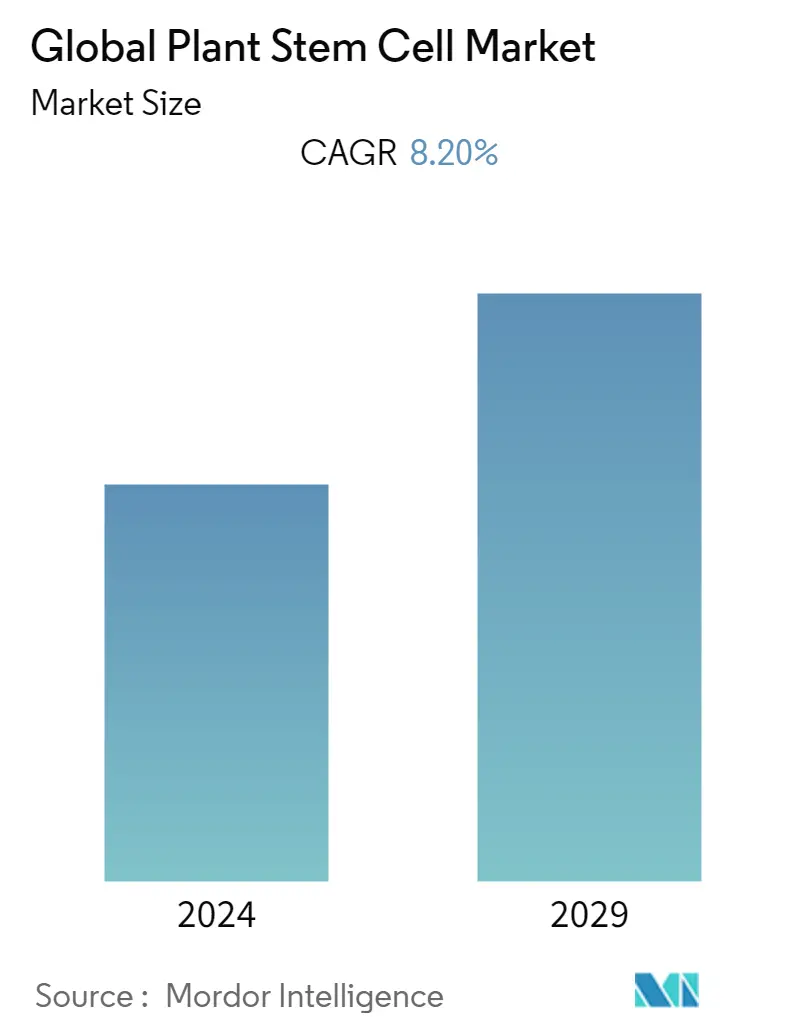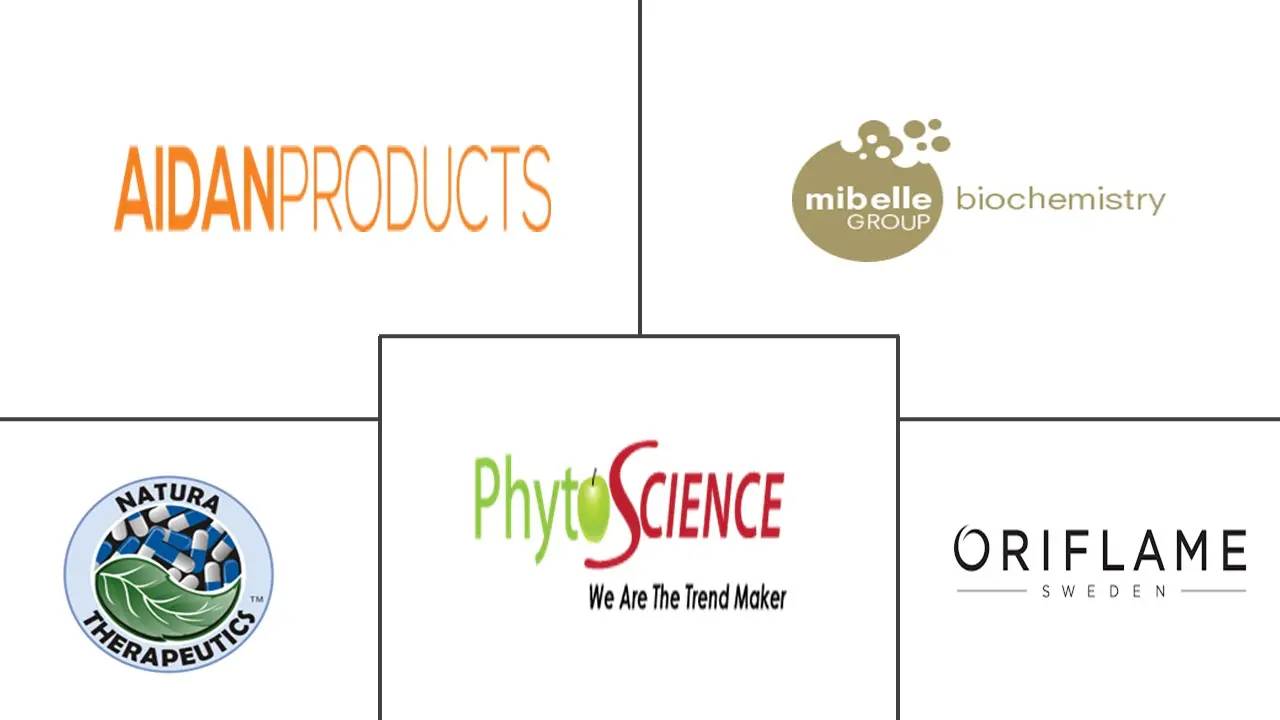Market Size of Global Plant Stem Cell Industry

| Study Period | 2019 - 2029 |
| Base Year For Estimation | 2023 |
| CAGR | 8.20 % |
| Fastest Growing Market | North America |
| Largest Market | Asia-Pacific |
| Market Concentration | Medium |
Major Players
*Disclaimer: Major Players sorted in no particular order |
Plant Stem Cell Market Analysis
The plant stem cell market is expected to grow at the registered CAGR of 8.2% during the forecast period, 2022-2027.
Since the emergence of COVID-19, there has been an increase in demand for nutritional products, as proper nutrition is required for proper immunity. The demand for cosmetics has increased among both men and women, which is expected to propel the plant stem cell market forward. According to the study titled "Natural Plant Products: A Less Focused Aspect for the COVID-19 Viral Outbreak," published in Plant Biotechnology in October 2021, despite prior good reports of plant-based treatments, there have been no successful clinical studies of Phyto-anti-COVID therapies to yet. Thus, hampering the market growth in COVID-19. Moreover, according to the study titled "Use of medicinal plants for COVID-19 prevention and respiratory symptom treatment during the pandemic in Cusco, Peru: A cross-sectional survey" published in the PLOS Journal in September 2021, found that mesenchymal stem cells (MSCs) and their exosomes (MSCs-Exo) can considerably reduce the risk of lung damage caused by alveolar inflammation and related pathological states, such as the one seen in COVID-19 patients.
The cosmetic industry has increased its demand for plant stem cells due to the numerous benefits they provide, such as whitening, tanning, moisturizing, washings, and skin rejuvenation. According to the study titled "Stem cells and the pursuit of youth, a tale of limitless possibilities and commercial fraud," published in the World Journal of Biological Chemistry in July 2021, online direct-to-consumer marketing of stem cell therapies in Japan, 83 % of websites in the Japanese online stem cell market promoted cosmetic procedures, compared to only 14% in the United States. Also, companies in the cosmetic industry are investing more in the research and development of new stem cell products and applications due to increased demand. As a result, the global plant stem cell market is expected to grow as demand for anti-aging, hair care, and skincare products rises. Because male consumers are becoming more interested in cosmetics and aesthetics, the market is expected to grow shortly.
Furthermore, increased product launches containing plant stem cells for topical use helps to protect skin stem cells from aging, which aids in the growth of the plant stem cell market. In March 2020, Mibelle Biochemistry's launched the PhytoCellTec Malus Domestica Hair, a plant stem cell active ingredient targeted to human hair stem cells. The technology reportedly protects hair stem cells against premature aging and loss. Additionally, in April 2019, Tremotyx Biomedical Lab released an over-the-counter eczema treatment based on plant stem cells. This new aloe vera-based treatment will benefit millions of eczema sufferers in the United States.
However, the high operational costs associated with extracting and manufacturing plant stem cell products are expected to limit the plant stem cell market's growth.
Plant Stem Cell Industry Segmentation
Plant stem cells are undifferentiated cells found in plant meristems. Plant stem cells are the source of plant vitality because they maintain themselves and provide a constant supply of precursor cells for the formation of various tissues and organs. Plant stem cells have two distinct properties: the ability to differentiate into different cell types and the ability to self-renew so that the number of stem cells remains stable. Processed extracts from the buds, roots, and shoots are in high demand and widely used for topical applications in the plant stem cell market, which focuses on the ability of plant cells. The plant stem cell market is segmented by location (root apical meristems, shoot apical meristems, and vascular meristems), application (nutrition, pharmaceutical, and cosmetics), and geography (North America, Europe, Asia-Pacific, Middle East and Africa, and South America). The market report also covers the estimated market sizes and trends for 17 different countries across major regions globally. The report offers the value (in USD million) for the above segments.
| By Location | |
| Root Apical Meristems | |
| Shoot Apical Meristems | |
| Vascular Meristems |
| By Application | |
| Nutrition | |
| Pharmaceutical | |
| Cosmetics |
| Geography | ||||||||
| ||||||||
| ||||||||
| ||||||||
| ||||||||
|
Global Plant Stem Cell Market Size Summary
The plant stem cell market is poised for significant growth, driven by increasing demand in the cosmetics and nutritional sectors. The rise in consumer interest in natural and organic products, particularly post-COVID-19, has fueled the market's expansion. The cosmetic industry, in particular, has seen a surge in the use of plant stem cells due to their beneficial properties in skincare, such as anti-aging and skin rejuvenation. This trend is further supported by the growing investment in research and development by cosmetic companies to innovate and introduce new products featuring plant stem cell technology. The market's growth is also bolstered by the introduction of novel products aimed at protecting and enhancing skin and hair health, although high operational costs associated with the extraction and manufacturing processes pose challenges.
Regionally, North America leads the plant stem cell market, benefiting from advanced technological capabilities and a strong demand for naturally derived products. The market is characterized by moderate competition, with several key players dominating the landscape. These companies are actively engaging in research and development to expand their product offerings and maintain their market positions. The introduction of new products, such as those targeting specific skin concerns or leveraging unique plant stem cell properties, is expected to further drive market growth. As the market continues to evolve, the integration of plant stem cell technology in various industries, particularly cosmetics, is anticipated to play a crucial role in shaping its future trajectory.
Global Plant Stem Cell Market Size - Table of Contents
-
1. MARKET DYNAMICS
-
1.1 Market Overview
-
1.2 Market Drivers
-
1.2.1 Rising Demand for Plant Stem Cells in the Cosmetic Industry
-
1.2.2 Increased Product Launches with Plant Stem Cells
-
-
1.3 Market Restraints
-
1.3.1 High Operational Cost with the Extracting and Manufacturing of Plant Stem Cell
-
-
1.4 Porter's Five Force Analysis
-
1.4.1 Threat of New Entrants
-
1.4.2 Bargaining Power of Buyers/Consumers
-
1.4.3 Bargaining Power of Suppliers
-
1.4.4 Threat of Substitute Products
-
1.4.5 Intensity of Competitive Rivalry
-
-
-
2. MARKET SEGMENTATION (Market Size by Value - USD million)
-
2.1 By Location
-
2.1.1 Root Apical Meristems
-
2.1.2 Shoot Apical Meristems
-
2.1.3 Vascular Meristems
-
-
2.2 By Application
-
2.2.1 Nutrition
-
2.2.2 Pharmaceutical
-
2.2.3 Cosmetics
-
-
2.3 Geography
-
2.3.1 North America
-
2.3.1.1 United States
-
2.3.1.2 Canada
-
2.3.1.3 Mexico
-
-
2.3.2 Europe
-
2.3.2.1 Germany
-
2.3.2.2 United Kingdom
-
2.3.2.3 France
-
2.3.2.4 Italy
-
2.3.2.5 Spain
-
2.3.2.6 Rest of Europe
-
-
2.3.3 Asia-Pacific
-
2.3.3.1 China
-
2.3.3.2 Japan
-
2.3.3.3 India
-
2.3.3.4 Australia
-
2.3.3.5 South Korea
-
2.3.3.6 Rest of Asia-Pacific
-
-
2.3.4 Middle East and Africa
-
2.3.4.1 GCC
-
2.3.4.2 South Africa
-
2.3.4.3 Rest of Middle East and Africa
-
-
2.3.5 South America
-
2.3.5.1 Brazil
-
2.3.5.2 Argentina
-
2.3.5.3 Rest of South America
-
-
-
Global Plant Stem Cell Market Size FAQs
What is the current Global Plant Stem Cell Market size?
The Global Plant Stem Cell Market is projected to register a CAGR of 8.20% during the forecast period (2024-2029)
Who are the key players in Global Plant Stem Cell Market?
Natura Therapeutics Inc, Aidan Products LLC, Mibelle Biochemistry, Phyto Science SDN BHD and Oriflame Holding AG are the major companies operating in the Global Plant Stem Cell Market.

